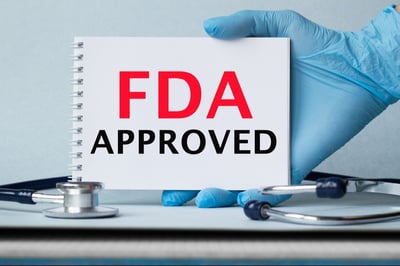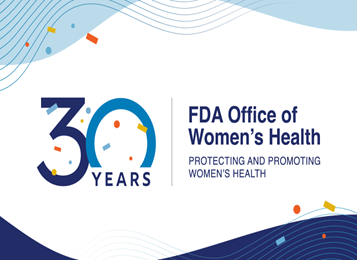Update: FDA in the News: FDA approvals and health information on breast cancer
This XRAY review reports new treatments approved by the FDA for early and metastatic breast cancer and educational resources about women's health. (Posted 8/4/25)

RELEVANCE
Most relevant for: People with breast cancer or at high-risk of breast cancer.
It may also be relevant for:
- people with breast cancer
- people with triple negative breast cancer
- people with Her2-positive cancer
- people with metastatic or advanced cancer
- people with ER/PR + cancer
- people newly diagnosed with cancer


Relevance: Medium-High


Research Timeline: Post Approval
The has approved several new treatments for breast cancer and expanded a past approval. These new treatment updates include:
- Kisqali: Two combinations approved for treating high-risk, HR-positive breast cancer.
- Datroway: Approved for certain breast cancers.
- Itovebi: Approved as a combined therapy for breast cancers with PIK3CA tumor mutations that grow after hormone therapy treatment. Read our recent XRAY review for more information.
- Enhertu: Previously approved for metastatic breast cancer and now expanded to include HER2-low and HER2-ultralow cancers (formerly called ). Read our recent XRAY review for more information.
These treatments reflect the progress being made to provide more targeted and effective breast cancer treatments. Below and on the next tab are additional details about Kisqali and Datroway.
Kisqali (ribociclib) combined treatment for , high-risk breast cancer
Kisqali is a type of known as a CDK4/6 inhibitor. Kisqali was recently approved for treating hormone receptor-positive () breast cancer. Combining Kisqali with a type of hormone therapy known as an aromatase inhibitor may provide greater benefit than treatment with an aromatase inhibitor alone.
Kisqali can be taken in one of two ways:
- As two separate pills: Kisqali with any aromatase inhibitor.
- As a single pill: Kisqali Femara Co-Pack. This combines Kisqali and Femara (letrozole), which is a type of aromatase inhibitor. These combined treatments are usually taken once daily for 21 days, followed by 7days off in a 28-day cycle.
These therapies are approved for people with 2 or 3 breast cancer that is , and considered at high risk for recurrence.
Kisqali side effects
Most side effects experienced by study participants were mild to moderate. The most common side effects were:
- Low blood cell counts (low neutrophils and white blood cells)
- Infections
- Fatigue
- Nausea
- Headache
- Liver problems
More serious side effects (grades 3-4) were rare but included:
- Low white blood cell counts
- 1% required discontinuing treatment
- Serious infections and skin conditions
- Changes in heart rhythms (QT interval changes)
- Most heart rhythm changes were reversible. However, one person who had both low potassium levels and a heart rhythm change died suddenly.
- Liver problems
- Lung inflammation (ILD)
- This is a rare but potentially life-threatening side effect that affects lung function. Symptoms include shortness of breath, cough and fatigue. This side effect is serious but treatable when caught early.
To monitor safety, regular heart and blood tests are done before and during treatment with Kisqali.
In the MONALESSA-7 study, 7% of people taking tamoxifen had a similar heart problem (prolonged QT interval). This was more frequent among people on Kisqali and tamoxifen (16%). Because the risk of this problem was higher when both drugs were taken together, the recommends avoiding using tamoxifen and Kisqali at the same time.
Additionally, Kisqali could harm fetuses during pregnancy, so avoiding pregnancy is recommended during treatment and for at least three weeks after the final dose.
Datroway (datopotamab deruxecan-dlnk) for advanced breast cancer
Datroway is a new treatment option for people with breast cancer that:
- is hormone receptor-positive ()
- is
- has already been treated with both hormone therapy and chemotherapy
Datroway is a type of known as an antibody-drug conjugate (ADC). The antibody portion delivers cancer-killing medicine directly to cancer cells that have a protein known as TROP2.
approval was based on results from a clinical trial called TROPION-Breast01, which included 732 people with advanced breast cancer who had previously had one or two lines of chemotherapy and were no longer responding to hormone therapy. Participants were randomly chosen to receive either Datroway or standard chemotherapy chosen by their physician.
Key findings
Participants who took Datroway:
- had a longer time before the cancer worsened
- Participants who received Datroway had 6.9 months before their cancer grew compared to 4.9 months among those treated with chemotherapy.
- more often had tumors shrink
- 36% of participants on Datroway had their tumor shrink compared to 23% of participants on chemotherapy.
- had similar overall survival
- Participants taking Datroway and those taking chemotherapy survived for just under 19 months after treatment began.
Datroway side effects
Most side effects of Datroway were mild to moderate; however, severe side effects occurred in some participants.
The most common side effects included mouth sores, nausea, eye problems and blood or metabolic abnormalities. Many of these side effects responded to treatment.
| Side effect | Percentage of participants with mild to moderate side effects | Percentage of participants with severe side effects |
| Any side effect | 94% | 15% |
| Mouth sores | 59% | 7% |
| Nausea | 56% | 1% |
| Dry eyes | 27% | under 1% |
| Cornea problems | 24% | 1% |
| Fatigue | 44% | 1% |
| Hair loss | 38% | 0% |
| Constipation | 34% | 1% |
| Blood or metabolic abnormalities | 20% | 3% |
| Lung inflammation | 4% | 1%* (0.3% died) |
* Interstitial lung disease (ILD) was rare (under 1%) but serious.
Most people who experienced lung inflammation recovered, but one person died from this complication. Doctors closely monitored for initial symptoms of ILD, which can include cough, shortness of breath, fever or other new or worsening respiratory symptoms.
Office of Women’s Health
This year marks the 30th anniversary of the ’s Office of Women’s Health (OWH). Since its creation in 1994, OWH has improved women’s health through research, education and public outreach.
OWH has supported over 400 research projects on important women’s health issues, such as heart disease, breast cancer and pregnancy-related conditions. This research helps to ensure that differences between women and men are considered in medical research and drug approvals.
Take Time to Care Program
In 1998, OWH launched the Take Time to Care (TTTC) program. This important initiative helps women access reliable, easy-to-understand health information, such as fact sheets, videos, webinars and free educational materials that support informed health decisions. The TTTC covers key women’s health topics such as birth control, menopause, medication safety and breast health (including the Pink Ribbon Guide).
To help share these resources with the community, OWH partners with healthcare providers, community groups, faith-based organizations, universities and more. Materials are available for free download or by mail in English, Spanish and many other languages.
Explore more about the health topics covered by the OWH and view or download their free publications.
Finding safe, high-quality services
The Quality Standards Act (MQSA) is a federal law enacted in 1992 to ensure that services in the U.S. are safe, reliable and of high quality. Its primary goal is to aid in the early detection of breast cancer by setting national standards for facilities.
Find a MQSA-approved service center near you.
Birth control information
The offers helpful information about various birth control (contraceptive) methods to support informed choices about preventing pregnancy.
Many options are available; however, some methods are more effective than others. The best choice for you depends on your health, lifestyle and personal preferences.
The also provides printable information from research studies of real-life use that shows the effectiveness of each method. The information is based on how many of 100 participants might become pregnant in one year while using a specific method. These rates help show how well different methods work in real-life situations.
If you are thinking about birth control, a healthcare provider can further explain your options to find the method that’s right for you.
U.S. Food and Drug Administration. approves ribociclib with an aromatase inhibitor and ribociclib and letrozole co-pack for early high-risk breast cancer. . Published September 17, 2024. Accessed May 24, 2025. https://www.fda.gov/drugs/resources-information-approved-drugs/fda-approves-ribociclib-aromatase-inhibitor-and-ribociclib-and-letrozole-co-pack-early-high-risk
U.S. Food and Drug Administration. approves datopotamab deruxtecan-dlnk for unresectable or , , breast cancer. . Published January 17, 2025. Accessed May 24, 2025. https://www.fda.gov/drugs/resources-information-approved-drugs/fda-approves-datopotamab-deruxtecan-dlnk-unresectable-or-metastatic-hr-positive-her2-negative-breast
U.S. Food and Drug Administration. approves fam-trastuzumab deruxtecan-nxki for unresectable or HR-positive, HER2-low or HER2-ultralow breast cancer. . Published January 27, 2025. Accessed May 27, 2025. https://www.fda.gov/drugs/resources-information-approved-drugs/fda-approves-fam-trastuzumab-deruxtecan-nxki-unresectable-or-metastatic-hr-positive-her2-low-or-her2
U.S. Food and Drug Administration. Birth Control. . Published 2024. Accessed May 27, 2025. https://www.fda.gov/consumers/womens-health-topics/birth-control
U.S. Food and Drug Administration. Free Publications for Women. . Published January 30, 2025. Accessed May 27, 2025. https://www.fda.gov/consumers/womens-health-topics/free-publications-women
U.S. Food and Drug Administration. information for patients. . Published 2024. Accessed May 27, 2025. https://www.fda.gov/radiation-emitting-products/mammography-quality-standards-act-mqsa-and-mqsa-program/mammography-information-patients
U.S. Food and Drug Administration. Take Time to Care Program. . Published 2024. Accessed May 27, 2025. https://www.fda.gov/consumers/owh-historical-information/take-time-care-program
U.S. Food and Drug Administration. Women's Health Topics. . Published January 31, 2025. Accessed May 27, 2025. https://www.fda.gov/consumers/womens-health/womens-health-topics
Disclosure: FORCE receives funding from industry sponsors, including companies that manufacture cancer drugs, tests and devices. All XRAYS articles are written independently of any sponsor and are reviewed by members of our Scientific Advisory Board prior to publication to ensure scientific integrity.
Share your thoughts on this XRAY review by taking our brief survey.
posted 8/4/25
The following organizations offer peer support services for people with or at high risk for breast cancer:
- FORCE peer support:
- Our Message Boards allow people to connect with others who share their situation. Once you register, you can post on the Diagnosed With Cancer board to connect with other people who have been diagnosed.
- Our Peer Navigation Program will match you with a volunteer who shares your mutation and situation.
- Connect online with our Private Facebook Group.
- Join our virtual and in-person support meetings.
- Other organizations that offer breast cancer support:
Updated: 05/07/2024
